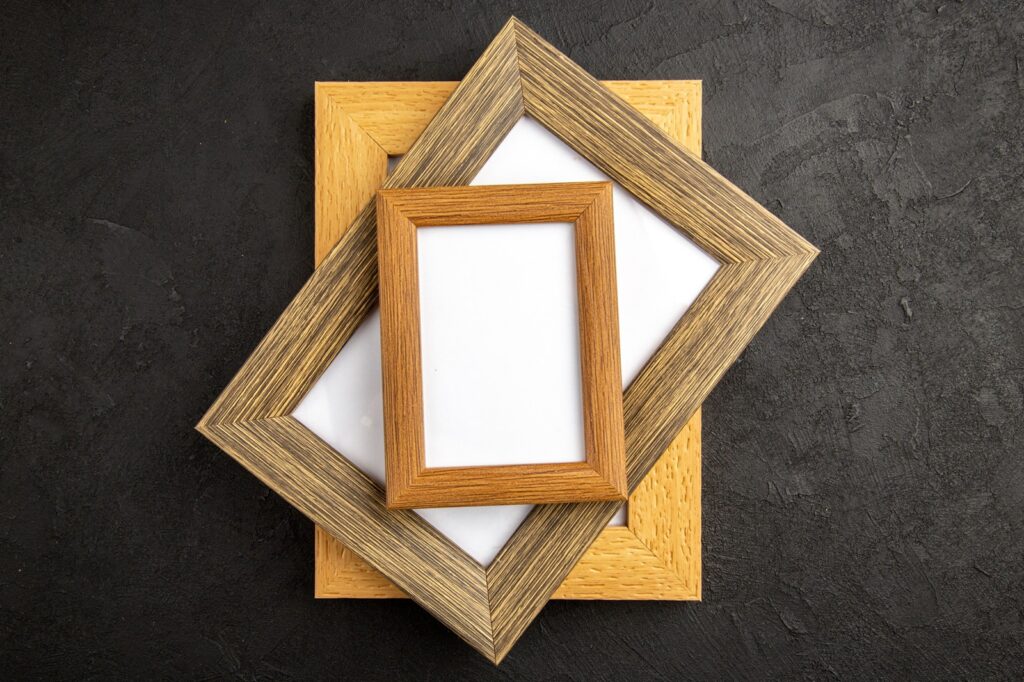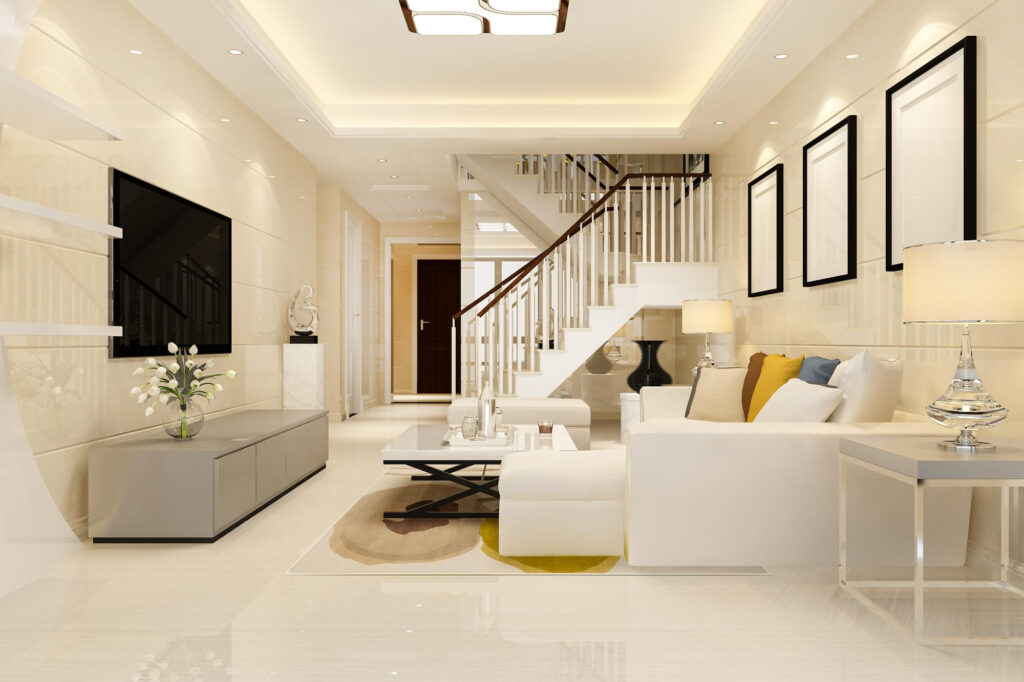Every piece in interior design contributes significantly to the mood and aesthetics of a room. By carefully selecting and arranging frames of appropriate sizes, you can enhance visual balance, create focal points, and imbue the space with character and charm. Picture frames, which are often disregarded, have the power to radically change the dynamics of a room. The size of picture frames is quite important in interior décor since it affects perceived space dimensions and highlights key points.
Key Takeaways:
- Picture frame size significantly influences room dynamics, affecting perceived space, focal points, balance, and visual flow.
- Larger frames can create a sense of grandeur and draw attention, while smaller frames foster intimacy and warmth.
- Properly sized frames contribute to visual balance and harmony within the space, complementing furniture and architectural features.
- Versatile frame sizes promote personalization and artistic expression, enhancing the overall ambiance and functionality of the room.
Perception of Space and Size
Whether you’re decorating a cozy corner or a grand living area, let the size of your picture frames be a guiding principle in elevating the ambiance and functionality of your home. Picture frames act as visual anchors inside a room, directing the observer’s sight and influencing the perceived scale of the area. Larger frames draw attention and provide a feeling of grandeur, making them excellent for open spaces or rooms with high ceilings. Smaller frames, on the other hand, can create a comfortable atmosphere in limited rooms, inviting closeness and warmth.
Focal Point Enhancement
Picture frames serve as focal points, drawing attention to cherished memories or captivating artwork. Choosing the right size for picture frames can increase the effect of focus points in a room. A huge frame strategically placed above a fireplace or mantle draws the eye and emphasizes the importance of the feature, but many smaller frames organized in a gallery-style layout can evenly spread focus throughout a wall, resulting in a harmonic visual balance.
Balance and Proportion
Properly sized picture frames contribute to a sense of balance and proportion within the space. Oversized frames may overwhelm a room, while undersized ones can get lost amidst the decor. Achieving harmony requires careful consideration of scale in relation to other elements in the room.
In interior design, achieving visual equilibrium is essential, and picture frame size is a key factor in keeping a room balanced. The overall coherence of the room is improved by a well-proportioned frame that balances the scale of surrounding objects like furniture and architectural features. Smaller frames provide subtle touches that break up bigger design schemes, while larger frames can bring drama and flair to minimalist homes.
Visual Flow
The size of picture frames influences the visual flow of a room. Larger frames command attention and can guide the eye along a desired path, while smaller frames create intimate vignettes. Strategic placement of frames of varying sizes can create visual interest and movement within the space.
Versatility and Harmonization with Room Layouts
The flexibility of picture frame sizes promotes personalization and artistic expression in home design. By combining various frame sizes, you can give walls more depth and dimension while also giving the space personality and character. There are countless ways to create dynamic visual tales inside a space by experimenting with scale, from establishing theme continuity to generating focus points.
- Create Visual Interest: Mix and match picture frame sizes to create visual interest and depth within the space. Experiment with asymmetrical arrangements to add a dynamic touch to walls and surfaces.
- Highlight Architectural Features: Use picture frames to accentuate architectural features such as windows, doorways, or built-in shelving. Properly sized frames can draw attention to these elements, adding character and charm to the room.
- Incorporate Reflective Surfaces: Opt for picture frames with reflective surfaces, such as glass or metallic finishes, to amplify light and create a sense of spaciousness. This technique is particularly effective in smaller rooms or areas with limited natural light.
Understanding the connection between picture frame sizes and room layouts is vital in order to achieve harmony with diverse architectural designs. Larger frames can define functional zones and serve as visual anchors to define regions for enjoyment or relaxation in open-concept spaces. Smaller frames, on the other hand, work well as accent pieces in complex wall arrangements or niche areas, offering visual appeal without overpowering the overall scheme.
Selecting the Right Picture Frame Size
When choosing picture frames, it’s essential to assess the dimensions of the room, the intended wall space, and the overall design aesthetic. Here are some key considerations:
Room Size and Ceiling Height
In spacious rooms with high ceilings, larger frames can make a bold statement without overwhelming the space. Conversely, in smaller rooms or areas with lower ceilings, opt for smaller frames to maintain proportion and prevent crowding.
Wall Space and Arrangement
Consider the available wall space when selecting picture frame sizes. A single large frame can anchor a wall and serve as a focal point, while a gallery wall comprised of smaller frames adds depth and dimension. Experiment with different arrangements to find the perfect balance for your space.
Wall Color and Texture
Take into account the color and texture of the walls where the frames will be displayed. Lighter walls may benefit from larger frames to create contrast and visual impact, while darker walls may require smaller frames to avoid overpowering the space. Additionally, textured walls can complement larger frames by adding depth and dimension to the overall composition.
Furniture Placement
Consider the placement of furniture in relation to the picture frames. Frames should harmonize with nearby furniture pieces in terms of scale and proportion. For example, if you have a substantial piece of furniture such as a sofa or bed, opt for larger frames to maintain visual balance. Conversely, if the furniture is more delicate or petite, smaller frames may be more appropriate.
Room Functionality
Think about how the room will be used and how the picture frames can enhance its functionality. For instance, in a formal dining room, larger frames with elegant artwork can elevate the space and create a sophisticated ambiance. In a casual living area, smaller frames with personal photographs can add warmth and intimacy. Tailor your frame sizes to suit the specific needs and atmosphere of each room.
Frame Style and Material
Beyond size, consider the style and material of the frames themselves. Traditional wood frames may lend a classic, timeless feel to a room, while sleek metal frames can impart a modern, contemporary aesthetic. Choose frames that complement the overall design scheme and reflect your personal taste and style preferences.
Future Flexibility
Lastly, think about the flexibility of your frame choices for future redecorating or rearranging. Opt for versatile sizes and styles that can adapt to changes in your decor over time. Modular or interchangeable frame systems offer the flexibility to easily update and rearrange artwork as your tastes evolve.
Artwork or Photograph Dimensions
Choose picture frame sizes that complement the dimensions of the artwork or photographs you wish to display. Oversized frames can overpower smaller pieces, while undersized frames may leave too much empty space. Aim for a harmonious relationship between the frame and its contents.
Case Studies and Examples
To illustrate the impact of picture frame size on room dynamics, let’s consider a few examples:
- Case Study 1: In a spacious living room with high ceilings, oversized picture frames featuring bold artwork create a sense of drama and sophistication.
- Case Study 2: In a cozy bedroom with limited wall space, a gallery wall of small frames adds personality and charm without overwhelming the intimate setting.
Expert Recommendations
Interior design experts advise the following tips for optimizing room dynamics with picture frames:
- Mix and match frame sizes and styles to add visual interest and dimension to the walls.
- Experiment with asymmetrical arrangements to create dynamic focal points.
- Incorporate mirrors within frames to maximize light reflection and create the illusion of space.
Tips for Optimizing Room Dynamics with Picture Frames
- Use picture frames strategically to define specific areas within an open-concept layout.
- Hang frames at eye level to ensure optimal viewing and engagement.
- Consider the reflective properties of glass or acrylic in frames to enhance natural light and brighten dark spaces.
DIY Solutions for Enhancing Room Dynamics
For those on a budget or who enjoy a hands-on approach to decor, consider these DIY ideas for enhancing room dynamics with picture frames:
- Repurpose old frames with a fresh coat of paint or decorative embellishments.
- Create a personalized gallery wall using a mix of family photos, artwork, and inspirational quotes.
- Incorporate floating shelves to display smaller frames alongside other decorative elements.
Case Studies and Examples
To illustrate the impact of picture frame size on room dynamics, let’s consider a few examples:
- Case Study 1: In a spacious living room with high ceilings, oversized picture frames featuring bold artwork create a sense of drama and sophistication.
- Case Study 2: In a cozy bedroom with limited wall space, a gallery wall of small frames adds personality and charm without overwhelming the intimate setting.
Expert Recommendations
Interior design experts advise the following tips for optimizing room dynamics with picture frames:
- Mix and match frame sizes and styles to add visual interest and dimension to the walls.
- Experiment with asymmetrical arrangements to create dynamic focal points.
- Incorporate mirrors within frames to maximize light reflection and create the illusion of space.
Tips for Optimizing Room Dynamics with Picture Frames
- Use picture frames strategically to define specific areas within an open-concept layout.
- Hang frames at eye level to ensure optimal viewing and engagement.
- Consider the reflective properties of glass or acrylic in frames to enhance natural light and brighten dark spaces.
DIY Solutions for Enhancing Room Dynamics
For those on a budget or who enjoy a hands-on approach to decor, consider these DIY ideas for enhancing room dynamics with picture frames:
- Repurpose old frames with a fresh coat of paint or decorative embellishments.
- Create a personalized gallery wall using a mix of family photos, artwork, and inspirational quotes.
- Incorporate floating shelves to display smaller frames alongside other decorative elements.
Conclusion
In summary, picture frame size greatly affects how a room feels, including how much space is perceived, how prominent the focal point is, how well-balanced the room is, and how adaptable the design is. The transformational power of picture frames may be utilized by interior designers and hobbyists alike to create engaging and harmonious living environments by carefully analyzing the scale and proportion of frames in relation to room dimensions and layout.
Frequently Asked Questions (FAQs)
What size picture frames are suitable for small rooms?
For small rooms, opt for smaller frames to avoid overwhelming the space. Consider creating a gallery wall with a mix of frame sizes for visual interest.
How can I use picture frames to improve acoustics in a room?
Choose larger frames with solid backing to absorb sound waves and reduce echoes. Alternatively, hang frames strategically to create a diffusive effect that disperses sound evenly throughout the room.
What are some creative ways to arrange picture frames on a wall?
Experiment with different layouts, such as grid patterns, asymmetrical arrangements, or overlapping frames. Mix and match frame sizes and styles for a dynamic display.
Are there specific picture frame materials that are better for room dynamics?
While the material of the frame itself may not have a significant impact on room dynamics, consider the backing material for acoustic effects. Solid backings can absorb sound, while open-back frames allow sound to pass through.
Can picture frames affect the perceived size of a room?
Yes, the size and placement of picture frames can influence the perceived size of a room. Larger frames may make a space feel more expansive, while smaller frames can create a cozy atmosphere.



